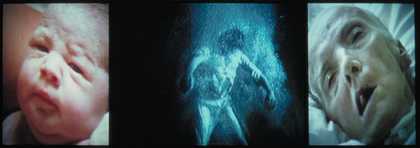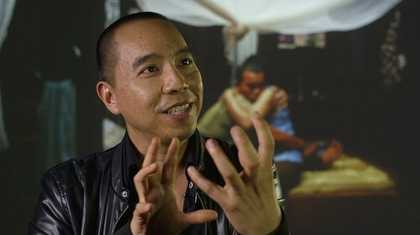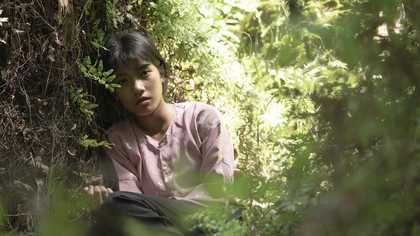
Thao Nguyen Phan First Rain, Brise Soleil (still) 2021 – ongoing
Cinematographer: Le Vu Anh Huy
Proposing an alternative understanding of water, land, borders and territories, my practice explores the architectural and political dimension of folklore in relation to land invasion, ethnic migration, and urban progress
Thao Nguyen Phan
Introduction
Thao Nguyen Phan (born 1987) interrogates the histories and potential futures of her homeland of Vietnam. Phan maps the turbulent history of the Mekong River with poetic observations of the diverse cultures and ecologies that rely upon it today. In painting, sculpture, moving image, and sound, the artist suggests a ‘softer, gentler kind of modernity’. She proposes a past and future in which the indigenous knowledge of Mekong communities is valued as much as modern progress.
The immense Mekong River sustains and connects populations from the Tibetan Plateau in China, through Myanmar, Laos, Thailand, Cambodia and Vietnam. Phan unveils the legacies of colonialism, industrial activity and the politicisation of natural resources in the Mekong Delta area. Her work reflects and reports on lesser-documented humanitarian catastrophes of famine, flooding and drought. These significant events have often been caused by human activity and have forever changed the people, landscapes and mythologies of the Mekong region.
Phan amplifies the oppressed and silenced stories of Vietnam, and in her new work, Cambodia. She works collaboratively with individuals and communities to develop new and inclusive narratives about the region and its history. Archive documents and oral records are dramatised through video and animation, merged with traditional silk painting and lacquerwork techniques. Combining voices and materials from different places and times, Phan collapses then redrafts the standardised histories of Vietnam and wider south-east Asia.
Dream of March and August

Thao Nguyen Phan August on a Honda Cub 2020 from Dream of March and August 2018 - ongoing. Photographed by Thao Nguyen Phan
This series of paintings (2018–ongoing) tells the tragic story of March (Ba) and August (Tám). The two fictional characters are named after the lowest-yield periods for food harvest in Vietnam. Phan depicts the months as a brother and sister who are separated by the tragic death of August during the Vietnamese famine of 1945–6. The siblings remain searching for the other across this life and the next.
Dream of March and August is largely told across pairs of images that are grouped together yet hung apart. The frames occupy the same space but suggest different physical and metaphorical planes. Borrowing a storytelling device used in Asian and European mythologies and history-making, Phan explains that ‘each half [is] the counterpoint to the other: disagreeing while supporting each other’. The history of the famine and the story of March and August are further told in the video work Mute Grain.
Perpetual Brightness
This work (2019–ongoing) considers the preservation of indigenous knowledge and cultural practices in the face of modern progression. It is Phan’s commentary on humanity’s ‘desire for a physical brightness, the brightness from electricity consumption and the brightness of the dollar bill, manifested in the accelerated speed of dam building on the Mekong’.
Phan’s double-faced sculpture references a geometric screen by the architect and designer Eileen Gray (1878–1976). Borrowing Gray’s composition, Phan also invokes elements of folklore and nature. One side depicts allegorical scenes including a Vietnamese ceremony of mourning for the spirits of beached whales. In the painting, the ritual uses red wine, a commodity from the Western market. Phan considers this as a parallel worshipping of tradition and modernity. The inverse side contains a fragmented lacquerwork map of the Mekong Delta. Phan chose lacquer for its relationship to water; it requires a humid atmosphere to cure and is created by depositing layers that are later sanded back, echoing how waterways are formed.
The Mekong’s course continues to be altered by human intervention and climate change. It no longer resembles the detailed route that Phan mapped in 2019.
Becoming Alluvium
This fictional story reveals the consequences of an imbalanced relationship between humans and the environment. The film is introduced by a poem about unity by Rabindranath Tagore. Tagore’s words on nature, nurture and misdirected love unlock Phan’s episodes about destruction, disintegration and rebirth. The opening story tells of a flood that causes the death of two brothers. The siblings remain forever bound to the Mekong River in cycles of reincarnation. Their story recounts the 2018 collapse of a hydroelectric dam in Laos which caused many deaths and displaced thousands of people.
The following ‘First Reincarnation’ captures the industrial life of the Mekong River, with readings from Marguerite Duras’s novel L’Amant (The Lover). The ‘Second Reincarnation’ overlays documentary footage of waste and excess with parables on consumption from Italo Calvino’s fictitious travelogue Le città invisibili (Invisible Cities). The fable concludes with a Khmer folktale about human greed and beauty. Phan’s animated characters reference the decapitated Khmer statues that were taken from Cambodia by colonising powers. They are superimposed onto engravings by Louis Delaporte, a French expeditionist and artist.
No Jute Cloth for the Bones
I went on a quest along the dike systems of the Red River in search of evidence for the once widely circulated dictum in the Japanese occupation period, ‘uproot rice, grow jute’
Thao Nguyen Phan
Phan’s fragmented curtain is made from stalks of dried jute. This strong, cheap material is often used to construct temporary shelters in Vietnam and south-east Asia, or as firewood. It was one of the inedible crops that Japanese authorities demanded farmers grow in place of food crops, preceding the devastating Vietnamese famine of 1945–6.
Stripping away the outer fibre of jute produces jute thread, the main product of this crop. For Phan, these unwrapped stalks become ‘bare bones, without skin, without flesh, without coverage [or] protection’. Suspended from the ceiling, Phan’s work clatters and rustles as it moves. The artist describes this sound as a ‘lullaby dedicated to the loss of lives, to the separations of the living and the dead, unable to reconcile due to the tragedies of war and famine.’
Mute Grain
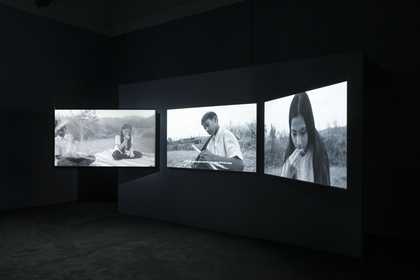
Thao Nguyen Phan Mute Grain 2019 Installed in Monsoon Melody, WIELS, Brussels, Belgium 2020
Photographed by Philippe de Gobert
Mute Grain (2019) reflects on the lesser-documented 1945–6 famine in French-Indochina (present-day Vietnam). Under Japanese occupation, Vietnamese farmers were forced to uproot food crops to plant higher-value inedible resources such as jute. In the ensuing seasons of famine, two million people are estimated to have died in the northern Red River Delta of Vietnam.
In Mute Grain, Phan considers the deep scars of famine left upon people, places and histories, and the continued fragility of food security in the region. Generations of Vietnamese families have preserved and shared accounts of the famine through storytelling and folklore. Counteracting the narrow official histories, Phan weaves a broader recollection from memories, archival photographs and oral records, with mythology and the writing of Yasunari Kawabata. At the centre of Phan’s chronicle a young man called March searches for his sister, August, who has died and become a ‘hungry ghost’.
The story of the famine continues in Phan’s painted series Dream of March and August.
Voyages de Rhodes
These paintings (2014–2017) are made onto pages from the book Rhodes of Viet Nam, written by Alexandre de Rhodes in 1653. Rhodes is known for his travel writing and for his transliteration of the Vietnamese language into the Roman alphabet. Developed with anonymous Vietnamese catechists in the 17th century, this Romanised system officially replaced Chinese script as the standard writing system in 1910, under French colonial rule.
Phan’s scenes respond to stories from the colonial missionary’s text. Often depicting children, the imagery shifts from sinister behaviours and situations to optimistic collective activities. In superimposing multiple representations of Vietnamese culture, Phan evokes the plurality of voices and viewpoints that are involved in the writing, transmission or erasing of histories.
First Rain, Brise Soleil
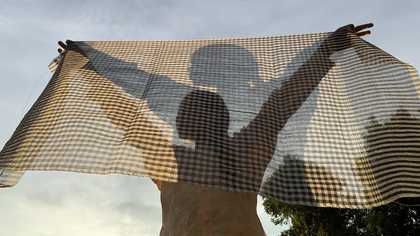
Thao Nguyen Phan First Rain, Brise Soleil (still) 2021 – ongoing
Cinematographer: Le Vu Anh Huy
This new work (2021–ongoing) explores the synergies and conflicts between historical continuity and modern progression. The first chapter is told through the memories of a construction worker. The character reflects on his work building brise soleil in Vietnam and Cambodia. These perforated concrete structures were developed to shade the interiors of buildings from intense heat and sunlight.
Phan contrasts images of the static, geometric brise soleil with scenes of the torrential ‘first rain’. This annual downpour marks the beginning of the fertile Monsoon agricultural season in south-east Asia but also causes flooding and disruption. The floods have been exacerbated by environmental changes caused, in part, by concrete production.
The final chapter retells a folk story of lost love, spanning Vietnam and Chenla (present-day Cambodia). It centres on the durian, a sweet but pungent fruit indigenous to the region. In Phan’s mythology, the durian becomes a symbol of loss and remembrance and a subtle comment on the conflicted history of Vietnam and Cambodia.
The Rise and The Flower
These light sculptures (2016) are found objects from Vietnam. They originally decorated the streets of Ho Chi Minh city (Saigon) during annual New Lunar Year celebrations and on occasions of the Communist Party Congress. The sunflower and bird shapes recall traditional Vietnamese symbols of harmony, prosperity and longevity. They also reference the symbolism used in state propaganda, such as the sunflower motif to represent the party.
Part of Phan’s series ‘Poetic Amnesia’, The Rise and The Flower are icons of both historic and contemporary Vietnamese culture. Understood by the artist as modern relics that light up the night, the works can also suggest other nights in the histories of Vietnam: times of bright memories, hope and good fortune, or endless hours of darkness as a backdrop to war, oppression and displacement.


